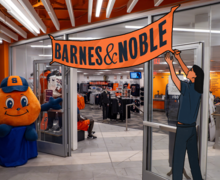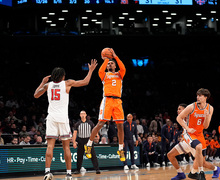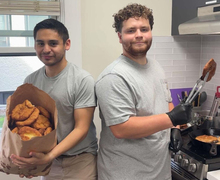City : Reeling in crime: SPD pushes to install security cameras
The police surveillance cameras aren’t installed above Sam Abdel’s business, but he can already picture the impact.
His customers may shop elsewhere to avoid being identified on camera, as many of them individually sell drugs, he said. Abdel, however, is willing to take the financial hit if some of them leave.
‘I’ll sacrifice hurting the business a little bit for more security,’ said Abdel, owner of the cell phone store Page West.
Since opening it in the Near Westside neighborhood of Syracuse 17 years ago, Abdel has suffered two break-ins. Now, a surveillance camera may be rising at his shop’s intersection of South Geddes Street and Grand Avenue, and Abdel said he believes the camera could deter other criminals.
‘Once they see the cameras there, I think they’ll be hesitant to commit a crime,’ he said.
Syracuse police and some city officials are hoping for the same result as they tackle a proposal to boost security in the Near Westside with nine surveillance cameras. But civil liberties groups and the city are divided on how effectively the cameras could fight crime now and in the future.
The city would use $125,000 in federal grant money to install the nine cameras, which could zoom in on the street and rotate vertically and horizontally. The Near Westside was chosen for the cameras because of its large number of reported gunshots.
Police have agreed to delete any recorded camera footage 14 days after it is captured. Unlike other cities, such as Rochester, police will not monitor the footage unless the cameras record a crime, in which case officers would place the footage on a disk and eliminate the original version after the 14-day period.
The Syracuse Common Council has postponed voting on the cameras’ placement twice this month, but will consider it again in its next meeting on Oct. 11.
‘My view is that the Syracuse Police Department are not the bad guys in this,’ said Syracuse Common Councilor Bill Ryan, chair of the city’s Public Safety Committee.
‘Cameras are being used extensively in this country and other countries. Whether we want to use them in Syracuse remains to be seen. We will have that discussion,’ he said.
Ryan plans to meet in October with members of neighborhood watch groups to receive their input. Questions about the cameras remain, such as if the footage can be subpoenaed and if federal government agencies can use it to pursue criminals, he said.
The cameras are meant to be overt, so they would have large blue lights that could turn on, off or flash, Ryan said.
But Ryan and SPD are split on the future of the cameras. At a Sept. 22 Common Council study session, Ryan emphasized the nine cameras would be a pilot program, yet SPD Capt. Richard Trudell confirmed police are interested in expanding Syracuse’s camera numbers to those of Rochester, where there are 110 cameras.
The long-term strategies of police elicited some concern at the latest Common Council meeting.
‘The police obviously have plans, we just don’t know what they are,’ said Barrie Gewanter, director of the Central New York chapter of the New York Civil Liberties Union, at the meeting.
Gewanter said an SPD policy shouldn’t be the only document with privacy protections and rules against misuse of the camera technology. The Common Council should create legislation to ensure those safeguards are in place, she said.
‘We should not move forward on trust alone,’ she said.
Some of the audience members at the council meeting broke into applause after Gewanter finished speaking.
The camera surveillance issue has moved from discussion to reality in Rochester, where police started installing cameras three years ago in high-crime areas, said Rochester police Sgt. Charles Gorman.
Police in Rochester determined the locations of high-crime areas by examining the number of emergency calls and citizen complaints. So far, the cameras have targeted drug dealers, gang activity and violent crime, Gorman said, leading to a decrease in drug deals on corners that used to have them.
‘They’re nowhere to be seen anymore,’ he said.
Gorman did not have any exact statistics on how much criminal activity had dropped. The cameras are monitored 24/7 by officers and public safety aids, who in many cases are retired police officers working part time for the city. From one camera room, the officers and aids can rotate the cameras 360 degrees.
Similar to the proposed cameras in Syracuse, the Rochester cameras are overt with blue flashing lights and have zoom lenses, Gorman said. With the overt design of the cameras, criminals know they exist, he said.
‘They’re going to think twice because the camera’s there,’ he said.
Evidence from other cities has shown cameras shift crime to outside the surveillance zones. A 2008 study by the University of California, Berkeley, on San Francisco’s 68 surveillance cameras found murders decreased in front of the cameras, but increased 250 to 500 feet away from the cameras.
Moving criminal activity still may make a difference, said William Snyder, a visiting assistant professor of law at Syracuse University who works at SU’s Institute for National Security and Counterterrorism.
‘It’s not a crime eliminator,’ Snyder said about camera surveillance. ‘It’s a crime reducer.’
When Snyder was a federal prosecutor, he used surveillance video of small-quantity drug transactions on the street to show how open-air drug markets worked. The camera footage is terrific evidence in court, especially when tracking patterns or movements, Snyder said.
‘It helps tremendously, because people have patterns in the way they commit crimes,’ he said.
But some Syracuse residents question the extent to which the proposed cameras could stop criminals.
‘How can a camera look at a person in a mask and tell who it is?’ asked Lenora Monkemeyer, who lives a few blocks away from the SU campus.
She argued criminals would just move to another area if cameras were installed. But her concerns also came down to personal freedoms with the camera surveillance.
‘It’s like a ‘Big Brother’ kind of thing,’ she said. ‘I think you lose individual freedom when you put it on the whole block.’
Published on September 29, 2010 at 12:00 pm





